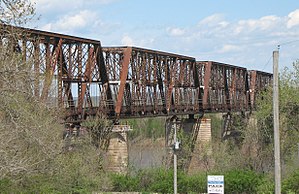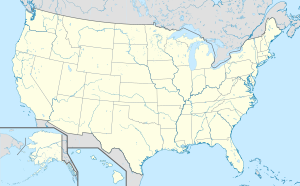Bellefontaine Bridge
Coordinates: 38 ° 50 ′ 36 " N , 90 ° 14 ′ 11" W.
| Bellefontaine Bridge | ||
|---|---|---|
| The Bellefontaine Bridge 2007 | ||
| use | Railway bridge | |
| Crossing of | Missouri River | |
| place | St. Charles County and St. Louis County , Missouri | |
| Entertained by | BNSF Railway | |
| construction | Truss bridge | |
| overall length | 802 m | |
| width | 9 m | |
| Longest span | 134 m | |
| Construction height | 17 m | |
| Clear height | 15 m | |
| building-costs | US $ 1.3 million | |
| opening | 1893 | |
| planner | George S. Morison | |
| location | ||
|
|
||
The Bellefontaine Bridge is a railway bridge over the Missouri River between St. Charles County and St. Louis County in the state of Missouri, USA. It was commissioned in 1893 as part of a northern double-track connection of the Chicago, Burlington and Quincy Railroad (CB&Q) to St. Louis , which also included the Alton Bridge over the Mississippi River , which was completed in 1894 . The extension of the line including the truss bridges was planned by George S. Morison and carried out under his direction. The Burlington Northern Railroad , as the successor to the CB&Q, later only used the route as a single track and gave up the Alton Bridge in the north in 1988. The BNSF Railway has been the operator of the now single-track bridge since 1995 . In 2013, she had the trestle bridge of the northern approach replaced by several girder bridges and, in the process, also carried out an overhaul of the lower chords of the four trusses .
history
Access to St. Louis

Due to the geographic location of St. Louis below the confluence of the Missouri and Mississippi rivers, railroad access from the east was only possible via the Mississippi and from the north only via the Missouri. Until 1890 there were only two railway bridges, which gave the respective operators a certain monopoly position. The first from 1871 to the west across the Missouri in Saint Charles on the Wabash Railroad and to the east across the Mississippi the Eads Bridge from 1874, which was under the control of the Terminal Railroad Association of St. Louis . The Chicago, Burlington and Quincy Railroad (CB&Q) joined their network from 1888 from the west on the St. Louis, Keokuk and North Western Railroad , which owned the route rights to the Wabash Railroad including over its bridge in Saint Charles. The high fees of the Wabash Railroad and a planned expansion of the railway facilities in St. Louis prompted the CB&Q to plan access from the north via the St. Clair, Madison and Belt Railway and their own bridges.
The railway company dedicated to the late 1880s, the bridge engineer George S. Morison had established that already three bridges over the Missouri for the CB & Q. Morison planned the northern access of the CB&Q above the mouth of the Missouri, where the two rivers run almost parallel for several kilometers, which required the construction of two railway bridges. Until 1893, the Bellefontaine Bridge was built southwest of Alton over the Missouri for the St. Louis, Keokuk and North Western and directly below the city until 1894 the Alton Bridge over the Mississippi for the St. Clair, Madison and Belt Railway (see No. 4 and 5 in the left figure above). The Bellefontaine Bridge also gave the Missouri, Kansas and Texas Railway (MK&T) access to the city, which in West Alton connected its network to the CB&Q route and secured route rights over the bridge to St. Louis for several years. The smaller railway companies controlled by the CB&Q, including their bridges, were later merged into the CB&Q, which in turn became part of the Burlington Northern Railroad in 1970 (since 1995 BNSF Railway ); the MK&T is now part of the Union Pacific Railroad .
Bridge over the Missouri
Along with Alfred Noble designed Morison in contrast to Alton Bridge high truss bridge without movable bridge part which 15 meters above Middle flood four means of caissons built power pillars rested. After the plans were approved by the War Department in December 1891, construction work began in early July 1892 after the spring floods had subsided. The steel bridge was completed by the end of the following year, the first train crossed the bridge on December 27, 1893. The double-track access to St. Louis was completed with the completion of the Alton Bridge in April 1894 by Morison.
Although the double-track expansion of the route from Burlington Northern was abandoned before 1985 - as photos in the HAER documentaion show - the Bellefontaine Bridge has been used almost unchanged for over 120 years and, along with the Merchants Bridge in St. Louis from 1890, is one of two Morisons' bridges Bridges preserved in their original form. However, the current operator BNSF had to replace the northern trestle bridge of the access road with several girder bridges in 2013 and in the process also overhauled the lower chords of the four trusses as well as some bridge piers and their supports .
In the 1920s, a road connection was built parallel to the railway, which crosses the rivers with the Lewis Bridge (1927) in the immediate vicinity of the Bellefontaine Bridge and the Clark Bridge (1928) parallel to the Alton Bridge . US Highway 67 has been running over the bridges since the 1940s, but the former truss bridges were replaced by modern multi-lane structures in 1979 and 1994.
description
The truss bridge consists, starting from southern abutment , of four 134 m long trusses made of steel , originally a 259 m long on the on the north bank trestle bridge of wrought iron followed. This was replaced in 2013 over a length of around 244 m by several steel girder bridges and a final 23 m long hollow box girder made of reinforced concrete to the northern abutment.
The parallel - chord trusses are designed in Baltimore construction (English baltimore truss , developed by the Pennsylvania Railroad and mainly built by the eponymous Baltimore Bridge Company ), with additional cross struts in the upper half of the trusses. The 17 m high and 9 m wide girders rest on four river pillars . These have a footprint of around 9 m × 20 m at the lower edge of the foundation and were lowered up to 25 m into the river bed; the clear height above mean flood is about 15 m.
See also
literature
- On Certain New Work in and about St. Louis. In: Railroad Gazette. Vol. 25, December 15, 1893, pp. 899-901.
- George S. Morison: The Bellefontaine Bridge: A Report to Charles E. Perkins, President of the Chicago, Burlington, and Quincy Railroad. Chicago 1894.
- Clayton B. Fraser: Nebraska City Bridge. Historic American Engineering Record, HAER No. NE-2, Denver, Colorado 1986, pp. 381-395.
Web links
- Bellefontaine Bridge, Saint Louis, Independent City, MO. Historic American Engineering Record, HAER MO-26.
- BNSF Bellefontaine Rail Road Bridge, Drone aerial footage, St. Charles County MO. Video documentation on YouTube ; accessed on May 4, 2018.
Individual evidence
- ^ Clayton B. Fraser: Nebraska City Bridge. Historic American Engineering Record, HAER No. NE-2, Denver, Colorado 1986, pp. 305-314.
- ^ On Certain New Work in and about St. Louis. In: Railroad Gazette. Vol. 25, December 15, 1893, pp. 899-901.
- ^ The History of BNSF. A legacy for the 21st century. BNSF Railway, p. 45. Retrieved April 21, 2018.
- ^ Clayton B. Fraser: Nebraska City Bridge. Historic American Engineering Record, HAER No. NE-2, Denver, Colorado 1986, pp. 381-395.
- ↑ SOUTH PORTAL; VIEW TO NORTH - Bellefontaine Bridge, Saint Louis, Independent City, MO. Historic American Engineering Record, HAER MO, 95-SALU.V, 1-7, 1985.
- ↑ Julie Sneider: Railroads pursuing massive bridge projects to support busier, heavier and faster traffic. Progressive Railroading, October 2013; accessed on April 23, 2018.
- ↑ a b BNSF Bridge 18.79 - Bridge Replacement and Modifications. St. Louis Bridge Construction; accessed on April 23, 2018.
- ↑ Lewis Bridge. Bridgehunter; accessed on April 30, 2018.
- ^ George S. Morison, The Bellefontaine Bridge: A Report to Charles E. Perkins, President of the Chicago, Burlington, and Quincy Railroad. Chicago 1894, p. 4.
- ^ Glenn A. Knoblock: Historic Iron and Steel Bridges in Maine, New Hampshire and Vermont. McFarland, Jefferson 2012, ISBN 978-0-7864-4843-2 , pp. 36 f.
- ^ George S. Morison, The Bellefontaine Bridge: A Report to Charles E. Perkins, President of the Chicago, Burlington, and Quincy Railroad. Chicago 1894, plates 2-14.




